Archaeological Discoveries - Archaeology of Ancient Assyria
![]()

The study of the archaeology of ancient Assyria is immense, to say the least. Who would have known that the exploration of ancient Assyria would have uncovered for us the most ancient literature of antiquity. Scattered within museums and collections on 3 continents (U.S., Europe and Asia) are the vast libraries of the ancient Assyrians, their historical chronicles, laws, civil records, military campaigns, Kingdom archives, diplomatic letters, educational tools, pronunciation charts, dictionaries, hymn books, financial transactions, contracts, maps, and texts relating to astrology, astronomy, mathematics, magical formulas, religious myths, and more.
There have actually been well over 300,000 clay tablets and inscriptions discovered so far with much more yet to be discovered. Also only approximately one-fifth of the discoveries have been deciphered and made available.
Tiglath-pilesar III�s Warriors Conquering a City

This gypsum relief is from the ancient Assyrian palace at Nimrud (Calah), the capital city. It depicts Tiglath-pilesar III�s mighty Assyrian warriors leading the inhabitants of a city near the Sea of Galilee (Astartu or Ashtaroth) and their sheep into captivity. It is now at the British Museum. Notice the city built on a mound.
It is interesting that the prophet Isaiah revealed that the territory surrounding the Sea of Galilee would be among the first to be conquered by the Assyrians and also the first to hear and see the Messiah. Jesus first began minister around the Sea of Galilee. (Isaiah 9)
Prisoners of Tiglath-pilesar III Led Into Captivity

These prisoners were the first to be taken into captivity by the enemy and over 700 years later the Messiah came and set people free from around the same area. (Isaiah 9)
Black Obelisk of Shalmanesar III

Austen Henry Layard uncovered this black basalt obelisk in Nimrud (Calah) in 1845. It is a six and a half foot tall monument commemorating the victorious campaigns of Shalmaneser III of Assyria (859-824 B.C.). It is shaped like a temple tower at the top, ending in three steps. It is now in the British Museum (see picture below).
King Jehu Bowing Before Shalmanesar III

This close up of the second panel reveals Israelites led by king Jehu of Israel paying tribute and bowing to the dust before king Shalmaneser III, who is making a libation to his god. We know it is Jehu because of the cuneiform text on the obelisk "Jehu the son of Omri". It also mentions his gifts of gold, silver, lead and spear shafts.
2 Kings 10:31
But Jehu took no heed to walk in the law of the LORD God of Israel with all his heart; for he did not depart from the sins of Jeroboam, who had made Israel sin.
King Jehu Bowing Before Shalmanesar III (Close Up)

2 Kings 10:36
"And the period that Jehu reigned over Israel in Samaria was twenty-eight years."
Shalmanesar III and Assyrian Cruelty

Bronze band from the gates of the palace of Shalmaneser III (852 B.C.) excavated at the site of Calah (Nimrud) revealing the horrifying cruelty of the Assyrians and the brutal treatment of their prisoners. British Museum
Shalmanesar III Attacking Hamath
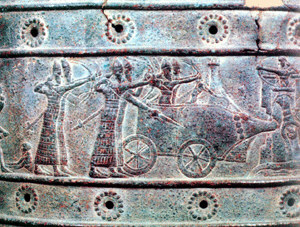
Isaiah 37:11-13 "Look! You have heard what the kings of Assyria have done to all lands by utterly destroying them; and shall you be delivered? Have the gods of the nations delivered those whom my fathers have destroyed, Gozan and Haran and Rezeph, and the people of Eden who were in Telassar? Where is the king of Hamath, the king of Arpad, and the king of the city of Sepharvaim, Hena, and Ivah?"'
This band from the bronze gates of Balawat shows the warriors of Shalmaneser III (858-824 B.C.) attacking the city of Parga in Hamath and breaking her walls with the battering ram, turning them into rubble. British Museum
Isaiah 25:12
"The fortress of the high fort of your walls He will bring down, lay low, And bring to the ground, down to the dust."
Tiglath-pilesar III (Pul)
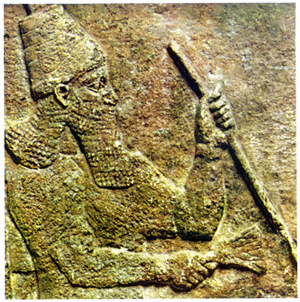
This 3 � plaster tablet of Tiglath-pilesar III was discovered at the central palace of Nimrud (Calah), the ancient capital of ancient Assyria. It is now at the British Museum. When Tiglath-pilesar III ascended the throne in 745 B.C. Assyria became a terror to the ancient world, especially to the northern kingdom of Israel who God gave into the hands of Tiglath�s invincible host. (2 Kings 15:19).
Tiglath-pilesar III made his move northward and then westward along the Fertile Crescent, his invincible army met little resistance, and one city after another became a vassal (tributary) to the Assyrians. As he journeyed southward he came to Samaria and its large walls that King Omri had built a century earlier. Israel surrendered without a fight. Israel�s king, Menahem, was able to pay off the Assyrians for a huge sum of money 1,000 talents of silver.
2 Kings 15:19-20 "Pul king of Assyria came against the land; and Menahem gave Pul a thousand talents of silver, that his hand might be with him to strengthen the kingdom under his control. And Menahem exacted the money from Israel, from all the very wealthy, from each man fifty shekels of silver, to give to the king of Assyria. So the king of Assyria turned back, and did not stay there in the land."
The cuneiform inscriptions of Tiglath-pilesar III read:
"I received tribute from Menahem of Samaria�Like a bird, alone he fled and submitted to me."
Tiglath-pilesar III�s Army Spoiling a City

Ezek 21:22 "..to set up battering rams, to call for a slaughter, to lift the voice with shouting, to set battering rams against the gates, to heap up a siege mound.."
This gypsum relief is from the ancient Assyrian palace at Nimrud, the capital city, depicts the utter destruction of the city of Gazru by Tiglath-pilesar III�s mighty Assyrian army. It is now at the British Museum. Notice the powerful battering ram to bring down the walls, at the top left are three men who have been impaled on spiked poles.
Sargon II Winged Bull

This winged creature (lamassu) was found at the palace of Sargon II at Dur-Sharruken (Khorsabad) right at the entrance to his throne-room standing 14 feet tall. Their were four statues on each side and they faced each other. It was believed that the lamassu could frighten off demons. [Oriental Institute, Chicago)
Sargon II Portrait

This limestone relief of Sargon II is from Khorsabad and stands 3 feet high. It is located at the Museo Egizio in Turin. He is wearing the Neo-Assyrian crown, notice the squat ball, ribbons, carefully weaved hair and beard, and earrings.
Sargon II and a General

Isaiah 20:1
"In the year that Tartan came to Ashdod, when Sargon the king of Assyria sent him, and he fought against Ashdod and took it"
This detail from a relief in the palace of Sargon II at Khorsabad (Dur-Sharruken) shows king Sargon II on the left and his Tartan, the commander-in-chief (field marshal) of his mighty army with his hand raised up. (2 Kings 18:17). The general is making his report in the audience chamber and is seen face to face with Sargon. (8th Century B.C.) British Museum.
Sargon II and a General (Close Up)
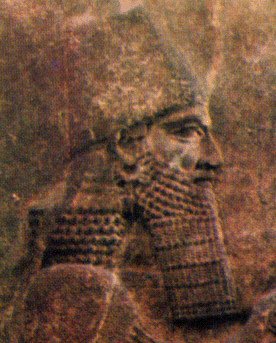
Notice king Sargon II with his proud look. He was the conqueror of Samaria and Israel and during his reign none opposed him.
Sargon II Inscription

This clay prism contains Assyrian inscriptions in cuneiform writing that validates the Biblical account regarding the capture and deportation of the northern kingdom of Israel in 722 B.C. The inscriptions records the 8th campaign of Sargon II in Syria and the revolts in Samaria, the capital of northern Israel, before and after Sargon�s campaigns. The Assyrian inscriptions also record king Sargon�s boasting, "I besieged and captured Samaria, and carried off 27,290 of its inhabitants as booty" (2 Kings 17:5-6). This cuneiform tablet is addressed to the god Asshur and is now in the Louvre, Paris.
Jewish Captives from Lachish

Isaiah 36:1-2
Now it came to pass in the fourteenth year of King Hezekiah that Sennacherib king of Assyria came up against all the fortified cities of Judah and took them.
This sculptured wall excavated at ancient Nineveh illustrates the fall of Lachish by the army of king Sennacherib and the inhabitants being driven into captivity. Before Sennacherib was routed at Jerusalem by the Angel of the Lord, he had captured 36 cities. British Museum
Sennacherib Exiles Lachish of Judah

Sennacherib�s Clay Prism

This beautifully preserved six-sided hexagonal prism of baked clay, commonly known as the Taylor Prism, was discovered among the ruins of Nineveh, the ancient capital of the Assyrian Empire. It contains the victories of Sennacherib himself, the Assyrian king who had besieged Jerusalem in 701 BC during the reign of king Hezekiah, it never mentions any defeats. On the prism Sennacherib boasts that he shut up "Hezekiah the Judahite" within Jerusalem his own royal city "like a caged bird." This prism is among the three accounts discovered so far which have been left by the Assyrian king Sennacherib of his campaign against Israel and Judah. Oriental Institute Chicago, Illinois
Interesting note: Egyptian sources make mention of Sennacherib�s defeat in the conflict with Judah, but gives the credit for the victory to an Egyptian god who sent field mice into the camp of the Assyrians to eat their bowstrings and thus they fled from battle.
(See 2 Kings 19; 2 Chronicles 32 and Isaiah 37)
Nabonidus Stele About Sennacherib

This basalt stele records the assassination of Sennacherib by his sons in 681 B.C. as a rebuke and consequence of the Assyrian god Marduk and his wrath upon Sennacherib for the destruction of Babylon.
This event happened just after Sennacherib had his unsuccessful campaign against Jerusalem and is recorded in the Bible:
2 Kings 19:35-37
35 And it came to pass on a certain night that the angel of the LORD went out, and killed in the camp of the Assyrians one hundred and eighty-five thousand; and when people arose early in the morning, there were the corpses -- all dead.
36 So Sennacherib king of Assyria departed and went away, returned home, and remained at Nineveh.
37 Now it came to pass, as he was worshiping in the temple of Nisroch his god, that his sons Adrammelech and Sharezer struck him down with the sword; and they escaped into the land of Ararat. Then Esarhaddon his son reigned in his place.
It is interesting that the Assyrian god , Nisroch, who king Sennacherib was worshipping at the time of his murder, was the Assyrian eagle-deity that is frequently depicted on Assyrian monuments.
Assyrians Carrying Away the Enemies Gods

This relief from ancient Nineveh shows the Assyrian soldiers of Sennacherib carrying off the statues of the gods of an enemy Syrian city. (2 Kings 18:34)
Siloam Inscription

2 Kings 20:20-21
"Now the rest of the acts of Hezekiah--all his might, and how he made a pool and a tunnel and brought water into the city--are they not written in the book of the chronicles of the kings of Judah? So Hezekiah rested with his fathers."
This Siloam Inscription from Jerusalem is so small, 15 inches high and 29 inches wide, yet its testimony is larger than life. It validates an amazing story that is mentioned in the Bible when king Hezekiah of Judah brought a new water-supply into Jerusalem while the city was under siege by the king of Assyria.
It states "The boring through is completed." This is the beginning of an inscription that was originally written in ancient Hebrew and discovered at the tunnel that king Hezekiah had built.
"And this was the story of the boring through. While the workmen were hacking their way from opposite ends, and while there were still three cubits to be bored through, they heard voices calling from each side, for there was a crevice in the rock. And on the day when the boring was completed the stone-cutters hacked their way toward each other until they met. The water flowed from the spring to the pool twelve hundred cubits, and the height of the rock above the heads of the stone-cutters was a hundred cubits."
The tunnel begins at the Gihon Spring in the Kidron Valley on the eastern side of Jerusalem, and then makes an S-shaped bend through the rock and finally reaching the Pool of Siloam about 30 feet lower. The work began at each side at the same time, as the inscription reads, and finally connected.
Hezekiah�s tunnel and the Pool of Siloam can still be seen today and is used as a reservoir and public bath.
The flatten rock with the inscription is now in the Istanbul Museum.
Esarhaddon Inscription
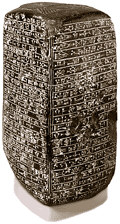
This basalt block describes the restoration of Babylon in 670 BC. by the Assyrian king Esarhaddon (681-669 BC). It is interesting that it was Nabopolassar of Babylon who later destroyed Assyria.
Assyrian Soldiers
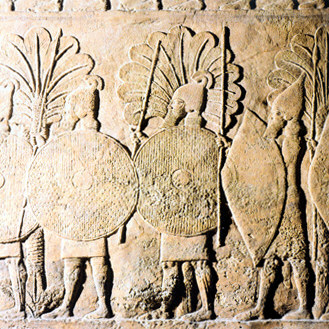
Warriors of Ashurbanipal�s royal bodyguard who are standing watch during a campaign in Babylon (640 B.C.). From the southwest palace of Ashurbanipal excavated at the site of ancient Nineveh. British Museum
Ashurbanipal in Chariot

This bas-relief from Ashurbanipal�s (669-633 B.C.) palace in Nineveh shows the king riding in his ceremonial chariot. The canopy shows his royalty. The king of Assyria was also high priest and deputy to the god Ashur, their chief deity.
Ashurbanipal�s War Chariots

This bas-relief reveals the strong Assyrian war-chariot which could carry 4 warriors. In front is a warrior on horseback with his bow drawn and quivers.
Ashurbanipal�s Army Hamanu Elam
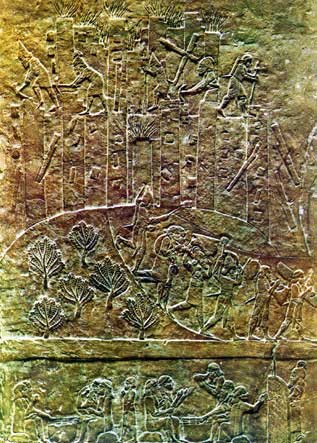
This relief from the palace of Ashurbanipal at Nineveh illustrates the capture of the city of Hamanu in Elam by Assyrian warriors. They are seen breaking the outer wall, burning their towers and gates. The troops are loaded with booty including Elamite prisoners. At the bottom right is an Assyrian guard watching over the captives. British Museum
Ashurbanipal�s Army Hamanu Elam (Close Up)
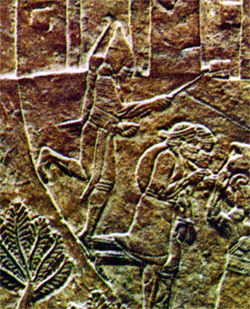
Close up of an Assyrian soldier leading two Elamite prisoners away from his home and into captivity.
Ashurbanipal

This relief of Ashurbanipal (668-626 B.C.) from Nineveh reveals the king carrying a basket on his head, symbolizing the kings personal involvement in the restoration of the temple of Esagila in Babylon. British Museum
Ashurbanipal (Close Up)

This close up of
king Ashurbanipal is reminiscent of king Solomon who was personally involved in
the construction of the Temple of Yah in Jerusalem.
![]()
Read The Bible
- 1599 Geneva Bible (GNV)
- 21st Century King James Version (KJ21)
- American Standard Version (ASV)
- Amplified Bible (AMP)
- Amplified Bible, Classic Edition (AMPC)
- Authorized (King James) Version (AKJV)
- BRG Bible (BRG)
- Christian Standard Bible (CSB)
- Common English Bible (CEB)
- Complete Jewish Bible (CJB)
- Contemporary English Version (CEV)
- Darby Translation (DARBY)
- Disciples’ Literal New Testament (DLNT)
- Douay-Rheims 1899 American Edition (DRA)
- Easy-to-Read Version (ERV)
- English Standard Version (ESV)
- English Standard Version Anglicised (ESVUK)
- Evangelical Heritage Version (EHV)
- Expanded Bible (EXB)
- GOD’S WORD Translation (GW)
- Good News Translation (GNT)
- Holman Christian Standard Bible (HCSB)
- International Children’s Bible (ICB)
- International Standard Version (ISV)
- J.B. Phillips New Testament (PHILLIPS)
- Jubilee Bible 2000 (JUB)
- King James Version (KJV)
- Lexham English Bible (LEB)
- Living Bible (TLB)
- Modern English Version (MEV)
- Mounce Reverse Interlinear New Testament (MOUNCE)
- Names of God Bible (NOG)
- New American Bible (Revised Edition) (NABRE)
- New American Standard Bible (NASB)
- New American Standard Bible 1995 (NASB1995)
- New Catholic Bible (NCB)
- New Century Version (NCV)
- New English Translation (NET)
- New International Reader's Version (NIRV)
- New International Version - UK (NIVUK)
- New International Version (NIV)
- New King James Version (NKJV)
- New Life Version (NLV)
- New Living Translation (NLT)
- New Matthew Bible (NMB)
- New Revised Standard Version (NRSV)
- New Revised Standard Version Catholic Edition (NRSVCE)
- New Revised Standard Version, Anglicised (NRSVA)
- New Revised Standard Version, Anglicised Catholic Edition (NRSVACE)
- New Testament for Everyone (NTE)
- Orthodox Jewish Bible (OJB)
- Revised Geneva Translation (RGT)
- Revised Standard Version (RSV)
- Revised Standard Version Catholic Edition (RSVCE)
- The Message (MSG)
- The Voice (VOICE)
- Tree of Life Version (TLV)
- World English Bible (WEB)
- Worldwide English (New Testament) (WE)
- Wycliffe Bible (WYC)
- Young's Literal Translation (YLT)
Table of Contents
Main Menu
- Ancient Assyrian Social Structure
- Ancient Babylonia
- Ancient Canaan During the Time of Joshua
- Ancient History Timeline
- Ancient Oil Lamps
- Antonia Fortress
- Archaeology of Ancient Assyria
- Assyria and Bible Prophecy
- Augustus Caesar
- Background Bible Study
- Bible
- Biblical Geography
- Fallen Empires - Archaeological Discoveries and the Bible
- First Century Jerusalem
- Glossary of Latin Words
- Herod Agrippa I
- Herod Antipas
- Herod the Great
- Herod's Temple
- High Priest's in New Testament Times
- Jewish Literature in New Testament Times
- Library collection
- Map of David's Kingdom
- Map of the Divided Kingdom - Israel and Judah
- Map of the Ministry of Jesus
- Matthew Henry Bible Commentary
- Messianic Prophecy
- Nero Caesar Emperor
- Online Bible Maps
- Paul's First Missionary Journey
- Paul's Second Missionary Journey
- Paul's Third Missionary Journey
- Pontius Pilate
- Questions About the Ancient World
- Tabernacle of Ancient Israel
- Tax Collectors in New Testament Times
- The Babylonian Captivity
- The Black Obelisk of Shalmaneser
- The Books of the New Testament
- The Court of the Gentiles
- The Court of the Women in the Temple
- The Destruction of Israel
- The Fall of Judah with Map
- The History Of Rome
- The Incredible Bible
- The Jewish Calendar in Ancient Hebrew History
- The Life of Jesus in Chronological Order
- The Life of Jesus in Harmony
- The Names of God
- The New Testament
- The Old Testament
- The Passion of the Christ
- The Pharisees
- The Sacred Year of Israel in New Testament Times
- The Samaritans
- The Scribes
Ancient Questions
- Why Do the Huldah Gates Appear Different in Ancient Replicas and Modern Photos?
- What Is the Origin of the Japanese and Chinese Peoples? A Biblical Perspective
- How did the ancient Greeks and Romans practice medicine and treat illnesses?
- What were the major contributions of ancient Babylon to mathematics and astronomy?
- How did the ancient Persians create and administer their vast empire?
- What were the cultural and artistic achievements of ancient India, particularly during the Gupta Empire?
- How did ancient civilizations like the Incas and Aztecs build their remarkable cities and structures?
- What were the major trade routes and trading practices of the ancient world?
- What was the role of slavery in ancient societies like Rome and Greece?
- How did the ancient Mayans develop their sophisticated calendar system?
Bible Study Questions
- Why Do Christians Celebrate Christmas?
- How Many Chapters Are There in the Bible?
- The Five Key Visions in the New Testament
- The 400-Year Prophecy: Unpacking Genesis 15 and the Journey of a People
- The Authorized (King James) Version (AKJV): Historical Significance, Translation Methodology, and Lasting Impact
- Exploring the English Standard Version (ESV): Its Aspects, Comparisons, Impact on Biblical Studies, and Church Use
- A Detailed Historical Analysis of Language Updates in the KJ21: Comparison with Other Versions
- A Detailed Historical Analysis of the American Standard Version (ASV): Comparison to the King James Version, Influence on Later Translations, and Evaluation of Strengths and Weaknesses
- A Detailed Historical Analysis of Amplifications in the Amplified Bible (AMP) and Its Comparison to Other Bible Translations
- Detailed Historical Analysis of the Amplified Bible Classic Edition (AMPC): Examples of Amplifications and Comparative Analysis with Other Bible Translations
About
Welcome to Free Bible: Unearthing the Past, Illuminating the Present! Step into a world where ancient history and biblical narratives intertwine, inviting you to explore the rich tapestry of human civilization.
Discover the captivating stories of forgotten empires, delve into the customs and cultures of our ancestors, and witness the remarkable findings unearthed by dedicated archaeologists.
Immerse yourself in a treasure trove of knowledge, where the past comes alive and illuminates our understanding of the present.
Join us on this extraordinary journey through time, where curiosity is rewarded and ancient mysteries await your exploration.
Recent posts
-

How to Build a Modern Slot Machine Engine: Math Models and RTP Design
Introduction: The Heart of Modern Slots Slot machines have evolved tremendously since the first mechanical reels appeared in the 1890s. Digital techno... -

Why Discipleship Ministries Matter: How They Shape Churches and Communities
Discipleship ministries have traditionally played an important role in Christians' spiritual growth and the long-term viability of their churches. Chr... -

A Historical Journey of Health Insurance: From Ancient Mutual Aid to Modern Coverage
The modern form of health insurance, which is premium based, pooled risk financial coverage during illness is a relatively new development. But the th... -

Get a Crypto License in Poland - Secure, EU-Ready, and Backed by Prifinance Expertise
Expand your crypto business legally in the European Union with a crypto license in Poland under the MiCA framework. Poland has become one of the most ... -

Why Partnering with the Right Mobile App Development Company Can Make or Break Your Project
Why Partnering with the Right Mobile App Development Company Can Make or Break Your Project In today's hyperconnected world, your app is frequently yo...